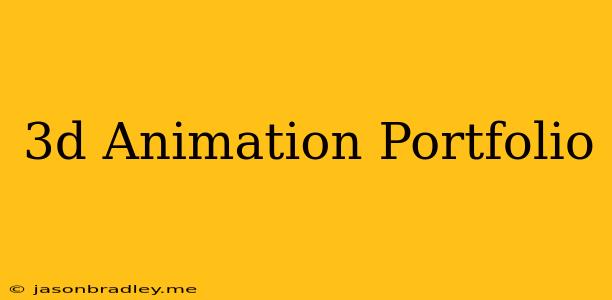Building a Killer 3D Animation Portfolio: A Guide for Aspiring Artists
As a 3D animator, your portfolio is your calling card. It showcases your skills, creativity, and technical abilities to potential employers or clients. Building a strong portfolio requires careful planning, thoughtful execution, and a focus on showcasing your unique strengths. This guide will help you create a portfolio that stands out and lands you your dream job.
1. Define Your Target Audience
Before you start creating, it's essential to understand who you are targeting. Are you aiming for a studio environment, freelance work, or a specific industry like games or film?
For studios, your portfolio should demonstrate your ability to work within a team, follow industry standards, and meet deadlines.
For freelance work, your portfolio should highlight your versatility, creativity, and ability to work independently.
For specific industries, your portfolio should showcase relevant projects and technical skills.
2. Choose Your Portfolio Format
The format of your portfolio depends on your target audience and personal preference.
Online Portfolios:
- Websites: Offer flexibility in design and customization. Platforms like Behance, ArtStation, and Wix are popular choices.
- PDFs: Allow for easy sharing and downloading, but offer less interactivity.
- Social Media: Sites like Instagram and Vimeo can showcase your work in a visually appealing manner, but might not be suitable for a comprehensive portfolio.
Physical Portfolios:
- Print Books: Still relevant, especially when meeting potential employers in person. Focus on high-quality images and clear layout.
- USB Drives: Convenient for carrying your work, but ensure compatibility and secure data.
3. The Power of Variety
Showcase a diverse range of your skills by including projects that demonstrate:
- Technical Proficiency: Demonstrate your knowledge of software (Maya, Blender, 3DS Max), rigging, animation techniques, lighting, and rendering.
- Character Animation: Focus on character movement, expressions, and storytelling.
- Environmental Animation: Show your ability to create dynamic environments and effects like fire, smoke, or water.
- Personal Projects: These showcase your passion and creativity.
Pro Tip: Include behind-the-scenes content to show your process and technical expertise.
4. The Importance of Quality
- High-Resolution Images: Use high-quality images that showcase your work's detail and visual impact.
- Clean and Minimalist Layout: Make your portfolio easy to navigate and focus on the quality of your work.
- Professional Presentation: Ensure your portfolio is free of typos, grammatical errors, and inconsistencies.
5. Keeping Your Portfolio Fresh
- Regularly Update: Add new projects to showcase your growth and keep your portfolio relevant.
- Refine and Improve: Don't be afraid to remove older projects and replace them with stronger examples.
- Seek Feedback: Get feedback from other artists and industry professionals to improve your portfolio's quality.
6. Promote Your Portfolio
- Social Media: Share your portfolio on relevant platforms like LinkedIn, Twitter, and Facebook.
- Networking: Attend industry events and workshops to connect with potential clients and employers.
- Online Communities: Engage with other artists on forums and online communities to gain visibility.
Remember, your portfolio is a reflection of your skills and creativity. By following these tips, you can create a portfolio that captures attention and sets you apart from the competition.
